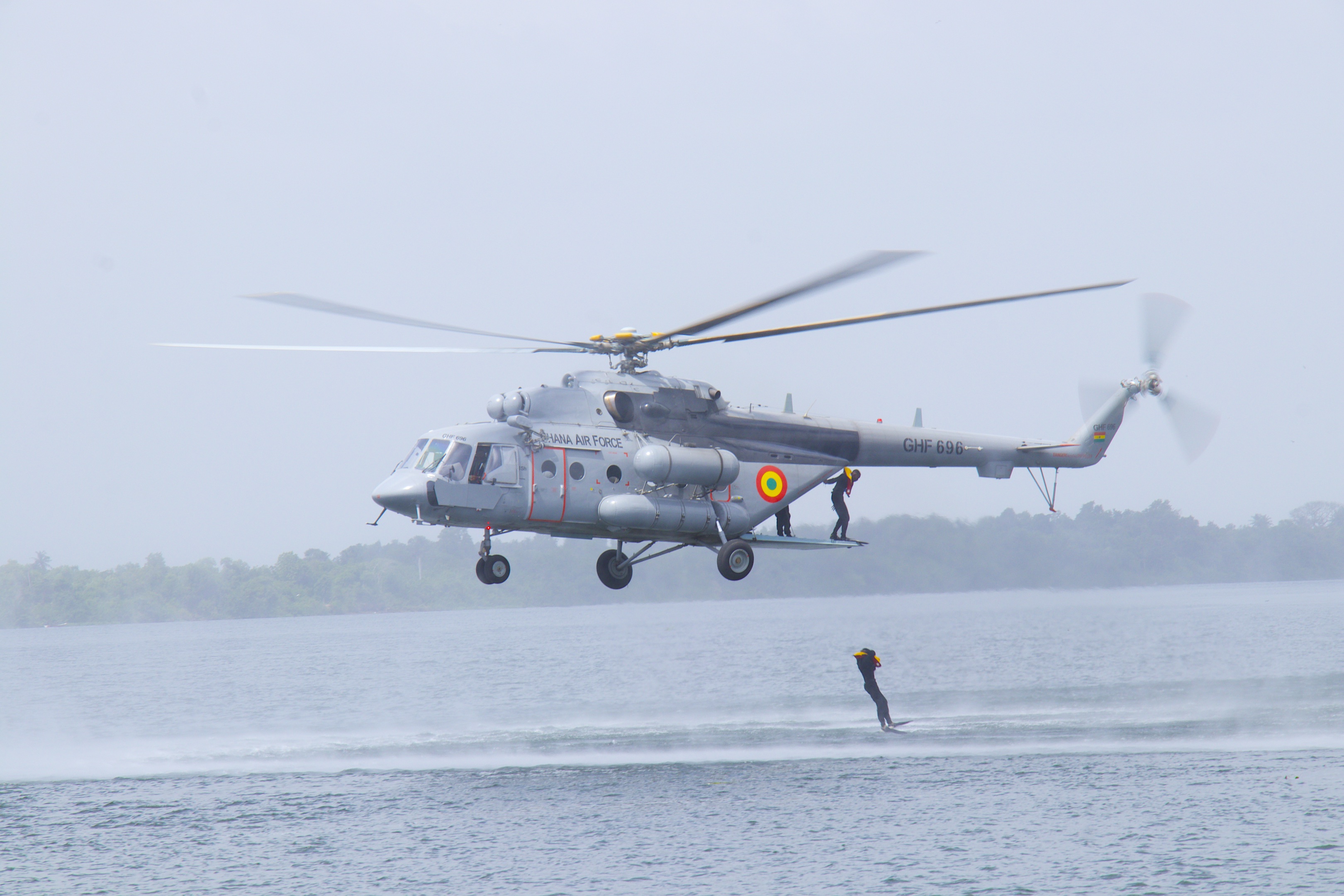
THE ROLE OF MARITIME PATROL AIRCRAFT
Ghana’s maritime domain covers its internal waters, territorial sea, contiguous zone, Exclusive Economic Zone (EEZ) and continental shelf. With a coastline of about 320 nautical miles (582 kilometres) and an EEZ of 200 nautical miles (364 kilometres), the maritime domain, minus the inland waters, covers an area of about 64,000 square nautical miles (116,480 square kilometres). It stretches from the border with Togo in the East to Cote d’Ivoire in the West and southwards into the Atlantic Ocean for 200 nautical miles (364 kilometres).
Ghana is also part of Zone F of the Maritime Security Architecture of the Yaoundé Code of Conduct in West Africa which extends 200 nautical miles offshore and stretches from Ghana to Guinea. In its maritime domain, Ghana has sovereign rights to explore, exploit, conserve and manage all resources within its maritime domain. This includes fishing, oil exploration, energy production, scientific research, mining, aquaculture and maritime commerce among others. The country also has the right to prevent infringement of its economic, customs, immigration or sanitary laws and to sanction those who breach these laws

Over the years, the country has relied on the Fishing Industry which earns over US$1 billion annually and employs over 2.2 million people. However, some of the fishermen use illegal fishing methods like the use of chemicals (DDT and Carbide), explosives (Dynamite), undersized nets, light fishing etc. This causes maritime pollution, leading to a drastic decline in the fish stock within the country’s EEZ. Other illegal methods of fishing include pair trawling which is banned in Ghana. This is because the practice leads to the netting of all sizes of fish and can potentially wipe out the fish stock in a short period of time.
The discovery of oil within the EEZ, along the country’s western boundary, has also brought along its associated challenges. These include maritime pollution, bunkering, and robbery activities. Piracy, drug trafficking and illegal transit of persons are other crimes that also occur within the EEZ. According to the International Maritime Bureau (IMB), in the first quarter of 2019, there were 38 incidents of piracy, kidnapping and armed robbery in the Gulf of Guinea. In 2020, there was 81 reported incidents, though this decreased to 34 in 2021.
Also, even though worldwide kidnappings reduced 55 percent in 2021, the Gulf of Guinea accounted for all global kidnappings resulting in 57 crew members abducted in seven separate events. Hence illegal fishing, piracy, robbery, kidnapping, smuggling and bunkering are a threat to the maritime economy.
Although the EEZ is saddled with the above-mentioned illegal activities, measures are in place to curb them. The increased number of international naval vessels and regional cooperation among the ECOWAS maritime forces helped to reduce illegal incidents in 2021. Exercise OBANGAME EXPRESS 2021 was an example of this type of cooperation. The exercise was aimed at increasing Regional Cooperation, Maritime Domain Awareness, and Information Sharing to improve regional naval forces’ abilities to counter sea-based illegal activities. Thus, continued patrols, exercises and increased cooperation are key to ensuring the safety of maritime operations in the Gulf of Guinea.
Ensuring maritime safety is the key responsibility of the Ghana Navy. However, the role of Ghana Air Force (GHF) to defend the territorial integrity of the country by air and its support to the Ghana Navy means that it has to provide surveillance capabilities. This is because the advantages of speed and reach provided by air power can help pinpoint the positions of vessels and persons involved in illegal activities for interdiction and apprehension by the Navy. This has been the bedrock of cooperation between the Ghana Navy and GHF.
Over the years, the GHF has employed its Diamond DA-42s, Casa C-295s, MI-17s and Z-9s to provide surveillance in support of Maritime Operations. The latest operation in early 2022 was the search for a suspected drug trafficking vessel which was planning to drop off drugs about 300 nautical miles offshore. This operation was carried out by the Casa C-295. The choice to use the C-295 was based on its speed, range, endurance and ability to communicate with the naval vessels and the Operations Centre from offshore. Although the mission was successfully carried out without incident, the use of contemporary technology, especially a Maritime Patrol Aircraft (MPA), would have provided a more effective and efficient result.
Maritime Patrol Aircraft are essentially multi-role surveillance platforms which in some cases can carry out three key roles: anti-submarine warfare, anti-surface unit warfare and Search and Rescue (SAR). They normally carry a multi-sensor suite which comprises radar, thermal imaging, infrared, and visible light cameras and trackers. For the Ghana Armed Forces, the surveillance and SAR roles, coupled with oilfield protection are relevant and this is fulfilled by the GHF’s C-295, DA-42 and various rotary winged aircraft being used as MPA.
However, dedicated MPAs will provide more advantages. Area coverage will be increased with the use of surveillance radar as this can cover more sea area than the cameras on the DA-42 or Z-9s. Recognition of targets will also be enhanced by the specialised software suite of MPAs which may carry current descriptions and status of almost all registered vessels in the world. These two attributes will reduce loiter time, save fuel and allow more area to be covered in each sortie. The dedicated MPA software will also ensure accurate and speedy acquisition of information about all vessels operating within the country’s maritime domain for tracking or interdiction purposes.
Another advantage will be the all-weather capability of the MPA which enables night-time operations using the thermal imaging and infrared cameras and detectors. A necessary characteristic of MPAs are built-in resources to enhance the survivability of the crew in the event of a ditching. This will also enhance the operational capability of the crew and enable them to operate far offshore to cover the whole EEZ. The ability to take pictures and videos of illegal activity involving vessels is an advantage when it comes to the prosecution of these vessels and their owners after arrest. If properly coordinated with an ‘all-of-government’ approach, the prosecution of persons involved in illegal activities in the maritime domain could offset some of the costs of the acquisition and operation of MPAs and naval vessels. Invariably, MPAs are very essential for the protection and mitigation of illegal activities in the maritime domain.
In conclusion, Ghana’s maritime domain which houses economic activities such as fishing, maritime commerce, aquaculture and oil exploration, continues to suffer interference in these activities owing to inadequate security. Piracy, armed robbery at sea, hijacking and kidnapping have also been identified as key threats to creating an enabling environment that facilitates economic activities in the EEZ.
The Ghana Navy’s efforts at curbing these threats may be limited without the support of the GHF in providing ‘eyes in the skies’. The existing airpower assets operated by the GHF’s C-295s, DA-42s, Z-9s and Mi-17s provide some of the needed support to the Ghana Navy in addressing these threats. However, a dedicated MPA isnecessary to ensure full coverage of Ghana’s EEZ to protect it from illegal activities and to help provide information to police the country’s maritime domain.







